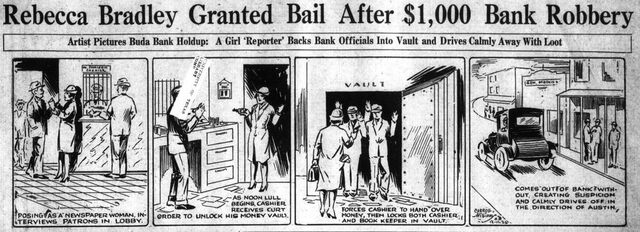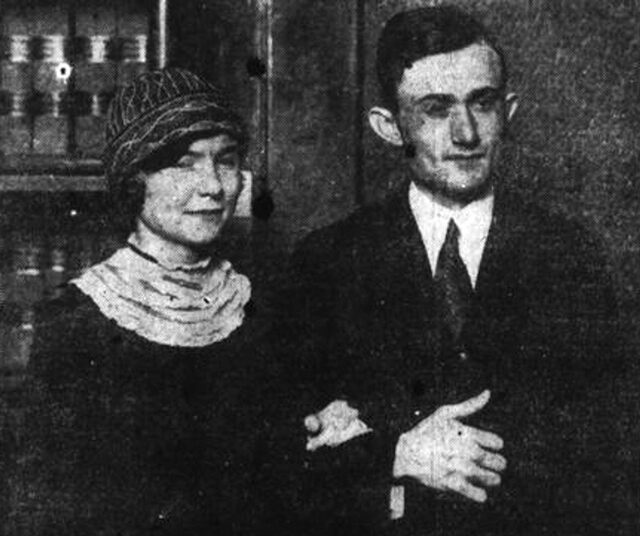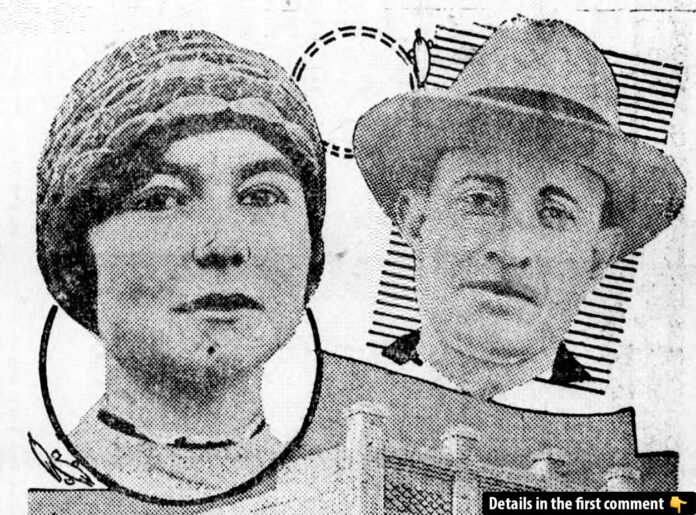In December 1926, the small town of Buda, Texas, witnessed an event that would captivate the nation: a young woman named Rebecca Bradley calmly executed a daring bank robbery, leaving a trail of fascination and controversy in her wake. Dubbed the “Texas Flapper Bandit” by sensationalist media, Bradley’s story became a lightning rod for the era’s anxieties about women’s growing independence. But was she a bold criminal or simply a victim of desperation and societal pressure?
A Crime That Stunned a Small Town
On the morning of December 11, 1926, Rebecca Bradley walked into Farmers National Bank in Buda, Texas. Posing as a journalist for the Beaumont Enterprise, she interviewed locals and gained the trust of the bank staff. When the moment was right, she turned the tables. Pulling out a .32 automatic pistol, she locked the bank tellers in the vault, ensuring they had enough air to survive before escaping with $1,000—equivalent to over $17,000 today. Despite her crime, the tellers described her as “courteous,” a detail that intrigued the press and public alike.

Video
Uncover the peculiar history of the Flapper Bandit of Buda, Texas – watch the video to learn about this intriguing figure and the wild story behind her escapades!
The Media’s “Flapper Bandit”
Within hours, newspapers across Texas splashed exaggerated headlines about Bradley’s heist, calling her a “Flapper Bandit.” The term evoked the image of a rebellious, daring woman, emblematic of the Roaring Twenties’ cultural shifts. Yet, Bradley’s life stood in stark contrast to the flapper archetype. She was a studious graduate student at the University of Texas, involved in community work, and a member of organizations like the Present Day Club, which promoted moral values.

The media’s fascination with Bradley wasn’t just about her crime. It reflected the societal unease of the time, as women gained the right to vote, entered the workforce, and embraced new fashions and freedoms. Female criminals, particularly those with short hair and bold personalities, became symbolic of these broader anxieties, fueling both fascination and fear.
Escape and Arrest
Bradley’s escape was as methodical as her crime. She took backroads to Austin but faced a setback when her car got stuck in the mud. A passing milkman helped her out, unwittingly aiding a fugitive. Once home, Bradley hid the gun and money in a chocolate box and mailed it to her university address, thinking she had covered her tracks. However, a Buda resident had noted her license plate, leading police directly to her. When confronted, Bradley reportedly quipped, “I have a whole lot to live down, but not as much as those men back there who let a little girl hold them up with an empty gun.”
A Second Crime Uncovered
As investigators dug deeper, they uncovered another crime. Just a day before the Buda heist, Bradley had attempted a robbery in Round Rock, Texas. Disguised as a journalist again, she set a vacant house on fire, hoping to lure the bank’s tellers outside. The plan failed, but witnesses—including a store owner who sold her kerosene and matches—later identified her as the arsonist. This revelation added another layer of intrigue to her story, painting her as both cunning and desperate.
The Trials and Public Reaction
Bradley’s arrest shocked those who knew her. Friends and colleagues described her as diligent and upstanding, insisting she was incapable of such acts. In her confession, Bradley admitted she had stolen money from her employer to support her mother and spiraled into debt trying to cover it up. Desperate to repay the $2,000 she owed, she saw robbery as her only option.
Her defense team argued she was mentally unstable, citing “dementia praecox” (now known as schizophrenia). In a courtroom rife with gender stereotypes, her attorneys claimed she was overwhelmed by societal pressures and unable to think rationally. One judge even suggested her menstrual cycle was to blame, a reflection of the era’s deep-seated biases. Despite these claims, Bradley’s candid confession and striking confidence in court made her a media darling.
The Media Darling
The press couldn’t get enough of the “Flapper Bandit.” Articles alternated between portraying her as a dangerous outlaw and an innocent victim of circumstance. Her wit, charm, and striking appearance captivated the public. She mocked male reporters and skillfully dodged photographers, further fueling her mystique. For some, she symbolized the modern woman—independent, daring, and unafraid to challenge societal norms.

The Legal Aftermath
Bradley’s legal battles dragged on for seven years, marked by hung trials and public fascination. Ultimately, the charges were dropped, and in 1933, just before giving birth to her first child, Bradley was officially cleared. She disappeared from the public eye, dedicating herself to family life. Her brief stint as the “Flapper Bandit” faded into obscurity, leaving behind questions about her motives and the era’s treatment of women.
Legacy of the “Texas Flapper Bandit”
Rebecca Bradley’s story is more than a tale of crime; it’s a reflection of a transformative era. The media’s portrayal of her as a flapper bandit reveals the cultural tensions of the Roaring Twenties, as women’s independence clashed with traditional values. While Bradley’s actions were undoubtedly criminal, they also highlighted the pressures faced by women navigating societal expectations and personal challenges.
In the end, Rebecca Bradley remains an enigma—a symbol of both empowerment and fear. Her story serves as a reminder of how societal narratives can shape our perceptions of individuals, especially women, in times of change. Whether seen as a cunning criminal or a desperate young woman, the “Texas Flapper Bandit” continues to intrigue and inspire, a testament to the complexities of history and human nature.
